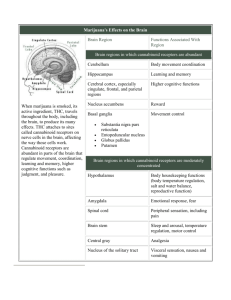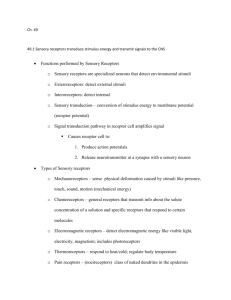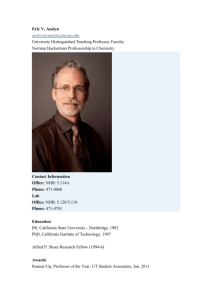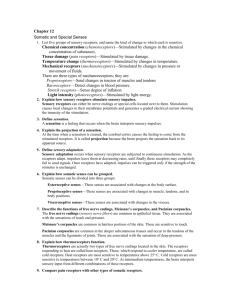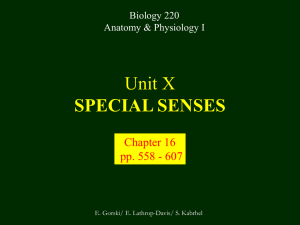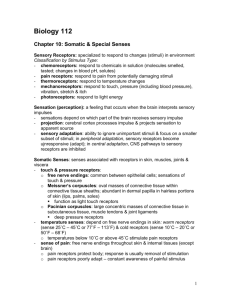Chapter 12
advertisement
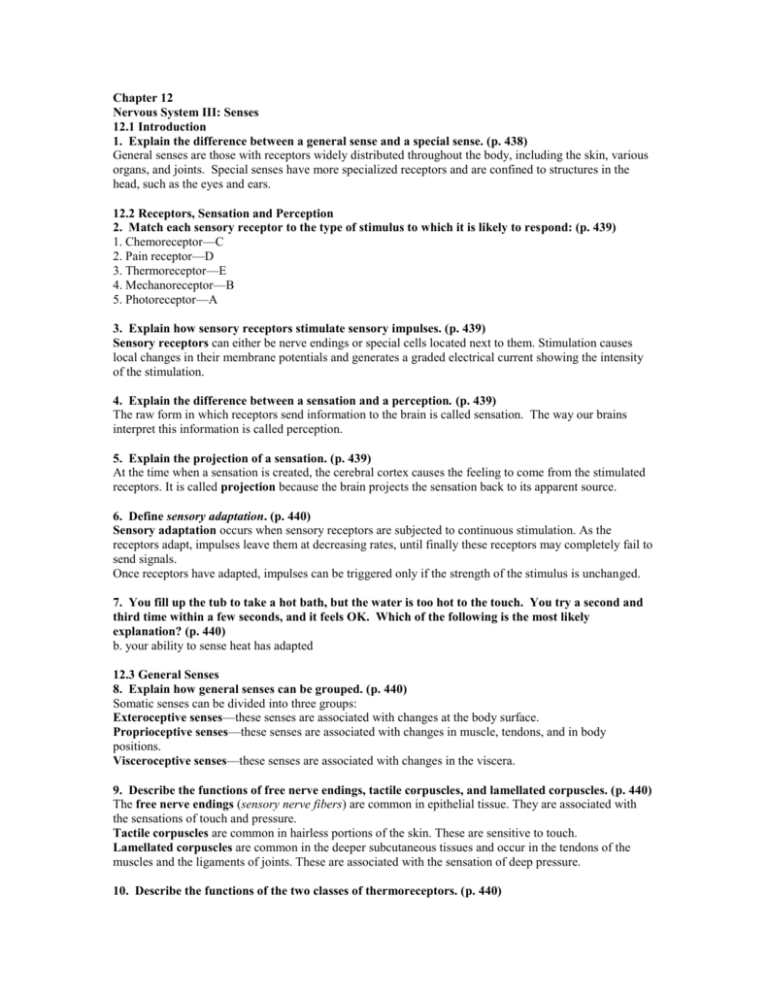
Chapter 12 Nervous System III: Senses 12.1 Introduction 1. Explain the difference between a general sense and a special sense. (p. 438) General senses are those with receptors widely distributed throughout the body, including the skin, various organs, and joints. Special senses have more specialized receptors and are confined to structures in the head, such as the eyes and ears. 12.2 Receptors, Sensation and Perception 2. Match each sensory receptor to the type of stimulus to which it is likely to respond: (p. 439) 1. Chemoreceptor—C 2. Pain receptor—D 3. Thermoreceptor—E 4. Mechanoreceptor—B 5. Photoreceptor—A 3. Explain how sensory receptors stimulate sensory impulses. (p. 439) Sensory receptors can either be nerve endings or special cells located next to them. Stimulation causes local changes in their membrane potentials and generates a graded electrical current showing the intensity of the stimulation. 4. Explain the difference between a sensation and a perception. (p. 439) The raw form in which receptors send information to the brain is called sensation. The way our brains interpret this information is called perception. 5. Explain the projection of a sensation. (p. 439) At the time when a sensation is created, the cerebral cortex causes the feeling to come from the stimulated receptors. It is called projection because the brain projects the sensation back to its apparent source. 6. Define sensory adaptation. (p. 440) Sensory adaptation occurs when sensory receptors are subjected to continuous stimulation. As the receptors adapt, impulses leave them at decreasing rates, until finally these receptors may completely fail to send signals. Once receptors have adapted, impulses can be triggered only if the strength of the stimulus is unchanged. 7. You fill up the tub to take a hot bath, but the water is too hot to the touch. You try a second and third time within a few seconds, and it feels OK. Which of the following is the most likely explanation? (p. 440) b. your ability to sense heat has adapted 12.3 General Senses 8. Explain how general senses can be grouped. (p. 440) Somatic senses can be divided into three groups: Exteroceptive senses—these senses are associated with changes at the body surface. Proprioceptive senses—these senses are associated with changes in muscle, tendons, and in body positions. Visceroceptive senses—these senses are associated with changes in the viscera. 9. Describe the functions of free nerve endings, tactile corpuscles, and lamellated corpuscles. (p. 440) The free nerve endings (sensory nerve fibers) are common in epithelial tissue. They are associated with the sensations of touch and pressure. Tactile corpuscles are common in hairless portions of the skin. These are sensitive to touch. Lamellated corpuscles are common in the deeper subcutaneous tissues and occur in the tendons of the muscles and the ligaments of joints. These are associated with the sensation of deep pressure. 10. Describe the functions of the two classes of thermoreceptors. (p. 440) Thermoreceptors are actually two types of free nerve endings located in the skin. The receptors responding to heat are called heat receptors. Those, which respond to cooler temperature, are called cold receptors. Heat receptors are most sensitive to temperatures above 25o C. Cold receptors are most sensitive to temperatures between 10o C and 20o C. At intermediate temperatures, the brain interprets sensory input from different combinations of these receptors. 11. Compare pain receptors with the other types of somatic receptors. (p. 440) Most pain receptors can react to more than one type of change. In other words, pain receptors may react directly to mechanical damage, chemical changes, by-products of metabolism, ischemia, hypoxia, or stimulation of other receptors such as mechanoreceptor. So, pain receptors are not usually limited to the specific types of stimulation that other somatic receptors are. 12. List the factors that are likely to stimulate visceral pain receptors. (p. 441) Factors that stimulate visceral pain receptors include: widespread stimulation of visceral tissues, stimulation of mechanoreceptors, and decrease blood flow accompanied by lower oxygen concentration and accumulation of pain-stimulating chemicals. 13. Define referred pain, and provide an example. (p. 441) Referred pain is a phenomenon that occurs when the pain feels as if it is coming from some part of the body other than the part being stimulated. An example would be pain that originates from the heart may actually be felt in the left shoulder or left arm. 14. Contrast the nerve pathways involved in the production of acute and chronic pain. Acute pain fibers conduct nerve impulses rapidly, at velocities up to 30 meters per second. These impulses are associated with the sensation of sharp pain, which typically seems to originate in a local area of skin. This type of pain seldom continues after the pain-producing stimulus stops. Chronic pain fibers conduct impulses more slowly than acute pain fibers, at velocities up to 2 meters per second. These impulses cause dull, aching pain sensations that are difficult to pinpoint. Chronic pain is felt in deeper tissues, as well as in the skin. 15. Explain how neuropeptides relieve pain. (p. 443) Neuropeptides called enkephalins and monoamine serotonin inhibit pain sensations by blocking the impulses from the presynaptic nerve fibers in the spinal cord. Enkephalins suppress both acute and chronic pain impulses much like morphine does. Serotonin stimulates other neurons to release enkephalins. Another group of neuropeptides are the endorphins. They are found in the pituitary gland, hypothalamus, and other regions of the nervous system. These act as pain suppressors with a morphine-like action. 16. Distinguish between muscle spindles and Golgi tendon organs. (p. 444) Muscle spindles are found in skeletal muscles near their junctions with tendons. Each spindle contains one or more modified skeletal muscle fibers enclosed in connective muscle tissue. Each fiber has a non-striated region with the end of a sensory nerve fiber wrapped around it. Golgi tendon organs are found in the tendons close to their muscle attachment and each is connected to a set of muscle fibers and innervated by a sensory neuron. 17. Explain how the senses of smell and taste function together to create the perception of the flavors of foods. (p. 446) Both olfactory and taste receptors are sensitive to chemical sensations. Because of this, we smell the food at the same time we taste it. Often, it is impossible to tell whether the sensation is mostly from the smell of a food or from the actual taste. 18. Which two of the following are part of the olfactory organs? (p. 446) a. olfactory receptors and b. columnar epithelial cells in the nasal mucosa 19. Trace each step in the pathway from an olfactory receptor to the interpreting center of the cerebrum. (p. 447) An olfactory receptor that has been stimulated causes nerve impulses to be triggered and travel along the axons of the receptor cells that are the fibers of the olfactory nerves. These fibers lead to neurons located in the olfactory bulbs that lie on either side of the crista galli of the ethmoid bone. In the olfactory bulbs, the impulses are analyzed and additional impulses are located within the temporal lobes and at the base of the frontal lobes just anterior to the hypothalamus. 20. Salivary glands are important in taste because ________. (p. 448) a. they provide the fluid in which food molecules dissolve 21. Name the five primary taste sensations and indicate a specific stimulus for each. (p. 449) Sweet as produced by table sugar. These receptors are most plentiful near the tip of the tongue. Sour as produced by vinegar. These receptors occur primarily along the margins of the tongue. Salty as produced by table salt. These receptors are most abundant in the tip and the upper front part of the tongue. Bitter as produced by caffeine or quinine. These receptors are located toward the back of the tongue. Umami as produced by the flavor enhancer monosodium glutamate. It is described as savory, pungent, and meaty. 22. Explain why taste sensation is less likely to diminish with age than olfactory sensation. (p. 450) This is due to the fact that the taste cells reproduce continually and only function for about three days. Damaged olfactory neurons are not replaced. 23. Trace each step in the pathway of a taste receptor to the interpreting center of the cerebrum. (p. 450) Sensory impulses from the taste receptors located in various regions of the tongue travel on fibers of the facial, glossopharyngeal, and vagus nerves into the medulla oblongata. From there, the impulses ascend to the thalamus and are directed to the gustatory cortex, which is located in the parietal lobe of the cerebrum along a deep portion of the lateral sulcus. 24. Match the ear area with the associated structure: (p. 450) 1. Outer ear—B 2. Middle ear—C 3. Inner ear—A 25. Trace each step in the pathway from the external acoustic meatus to hearing receptors. (p. 450) The sound waves enter the external auditory meatus. Changes of wave pressures cause the eardrum to reproduce the vibrations coming from the sound wave source. Auditory ossicles amplify and transmit the vibrations to the end of the stapes. Movement of the stapes at the oval window transmits vibrations to the perilymph in the scala vestibuli. Vibrations pass through the vestibular membrane and enter the endolymph of the cochlear duct. Different frequencies in the endolymph stimulate different sets of receptor cells. 26. Describe the functions of the auditory ossicles. (p. 452) The bones form a bridge connecting the tympanic membrane to the inner ear. They function to transmit vibrations between these parts. 27. Identify the parts of the tympanic reflex, explain how they work, and explain the importance of this reflex. (p. 452) The tympanic reflex consists of two skeletal muscles associated with the middle ear that are controlled involuntarily. The reflex is elicited by long, external sounds causing the bridge of the ossicles to become more rigid, reducing its effectiveness in transmitting vibrations to the inner ear. The tympanic reflex reduces pressure from loud sounds that might otherwise damage the hearing receptors. 28. The function of the auditory tube is to ________. (p. 453) a. equalize air pressure on both sides of the eardrum 29. Distinguish between the osseous and the membranous labyrinths. (p. 453) The osseous labyrinth is a bony canal in the temporal bone. The membranous labyrinth is a tube that lies within the osseous labyrinth and has a similar shape. 30. Describe the cochlea and its function. (p. 453) The cochlea contains a bony core and a thin bony shelf that winds around the core like the threads of a screw. It functions in hearing by allowing the sound vibrations from the perilymph to travel along the scala vestibule and pass through the vestibular membrane and into the endolymph of the cochlear duct where they cause movements in the basilar membrane. It then stimulates the organ of Corti, which contains the hearing receptors. 31. Which of the following best describes hearing receptor “hair cells?” (p. 456) c. they are epithelial, but function like neurons 32. Explain how a hearing receptor stimulates a sensory neuron. (p. 456) The cell releases a neurotransmitter that stimulates the nearby sensory nerve fibers, and they transmit impulses along the cochlear branch of the vestibulocochlear nerve to the auditory cortex of the temporal lobe of the brain. 33. Trace each step in the pathway from the spiral organ to the interpreting centers of the cerebrum. (p. 456) Once the sound is converted into a nerve impulse at the organ of Corti, it travels along the cochlear branch of the vestibulocochlear nerve to the auditory cortex of the temporal lobe of the brain. On the way, some of the nerve branches cross over, so that impulses from both ears will be interpreted by both sides of the brain. 34. Describe the organs of static and dynamic equilibrium and their functions. (p. 459) The organs of static equilibrium are located within the vestibule, a bony chamber between the semicircular canals and cochlea. The membranous labyrinth inside the vestibule consists of two expanded chambers—an utricle and a saccule. The macula is on the anterior wall of the utricle that contains numerous hair cells and supporting cells. These sense the positions of the head and help in maintaining the stability and posture of the head and body when these parts are motionless. The organs of dynamic equilibrium are located within the three semicircular canals. Suspended in the perilymph of the bony portion of each semicircular canal is a membranous canal that ends in a swelling called the ampulla. The sensory organs are located here. These organs are called the crista ampullaris and contain a number of hair cells and supporting cells. These function to detect motion of the head and aid in balancing the head and body when they are moved suddenly. 35. Explain how the sense of vision helps maintain equilibrium. (p. 461) The eyes detect the body’s position relative to its surroundings. For this reason, the eyes help the brain maintain equilibrium, especially if the other organs of equilibrium are damaged. 36. Match the visual accessory organ with its function: (p. 462) 1. Eyelid –B 2. Conjunctiva –C 3. Lacrimal gland –D 4. Extrinsic muscles—A 37. Name the three layers of the eye wall and describe the functions of each layer. (p. 465) Outer fibrous tunic—serves as the cornea and sclera. The cornea functions as a window to the eye and helps focus entering light rays. The sclera provides protection and serves as an attachment for the extrinsic muscles . Middle vascular tunic—includes the choroid coat, which helps to absorb excess light so the inside of the eye is dark; the ciliary body, which forms the ciliary muscles and processes; and the iris, whose smooth muscle control the pupil size. Inner nervous tunic—consists of the retina, which contains the visual receptor cells. 38. Explain why looking at a close object causes fatigue in terms of how accommodation is accomplished. (p. 467) Accommodation results from the suspensory ligaments either relaxing or pulling due to decreased or increased tension from the suspensory muscles. This allows people to see objects either close up or more distant. 39. Explain the mechanisms of pupil constriction and pupil dilation. (p. 468) The smooth muscle fibers of the iris are arranged into two groups, a circular set and a radial set. The circular muscles act as a sphincter to decrease pupil size. The radial muscles contract to increase the diameter of the pupil. 40. Distinguish between the fovea centralis and the optic disk. (p. 469) The macula lutea is a small spot on the retina. In its center is a depression called the fovea centralis, which has the sharpest vision. The optic disk is just medial to the macula lutea and is the area where the optic nerve begins and blood vessels enter and exit. This area has no receptors, and is known as the blind spot of the eye. 41. All of the following are compartments in the eye. In which one is vitreous humor found? (p. 469) d. posterior cavity 42. Explain how light is focused on the retina. (p. 471) As light enters the eye, it is refracted, or bent, by the cornea and lens and is focused sharply on the retina. The image is projected upside down and reversed from left to right. The visual cortex somehow corrects this when it interprets the images. 43. Distinguish between rods and cones. (p. 473) Rods are receptor cells that have long thin projections at their terminal ends. Rods are hundreds of times more sensitive to light than cones. This enables people to see in relatively dim light. Rods produce colorless vision. Cones are receptor cells that have short, blunt projections. Cones allow for increased visual acuity—the sharpness of images perceived. Cones make up the entire fovea centralis. Cones also detect colors of light. 44. Explain why cone vision is generally more acute than rod vision. (p. 473) When the images are being sent from the rods and cones to the brain, the nerve fibers of the rods converge and send all of the images on a single tract. The brain can interpret the images, but cannot tell specifically which rod a particular part came from. The cones converge their nerve fibers to a much lesser degree. This allows the brain to interpret the images more accurately and sharply. 45. Describe the function of rhodopsin. (p. 473) Rhodopson (visual purple) is the light-sensitive substance in the rods. Bright light decomposes rhodopsin rapidly so the sensitivity in the rods is greatly reduced. Thus, this pigment allows us to see in dim light. 46. Explain why rod vision may be more important under dim light conditions. (p. 475) Rods are hundreds of times more sensitive to light than are cones. 47. Describe the relationship between light wavelength and color vision. (p. 475) The wavelength of a particular kind of light determines the color perceived. The cones in the eyes each have a certain pigment that is stimulated by certain wavelengths. Some cones have erythrolabe pigment that is sensitive to red light waves, some have chlorolabe which is sensitive to green, and some have cyanolabe which is sensitive to blue. The combinations of these stimulations give us color vision. 48. Define stereoscopic vision. (p. 475) Steropsis allows a person with binocular vision (using both eyes) to perceive distance, depth, width, and height of an object. 49. Explain why a person with normal binocular vision is able to judge distance and depth of close objects more accurately than a person who has lost one eye. (p. 475) This happens because the eyes are separated and see slightly more of one side than the other (the left eye sees more left and the right eye sees more right). The impulses are superimposed in the brain and give us a three-dimensional view of the object. A person using only one eye cannot see “both sides” of the object at the same time. Thus, the object appears two-dimensional. 50. Trace each step in the pathway from the retina to the visual cortex. (p. 475) The axons of the retinal neurons form the optic nerves. These nerves enter the X-shaped optic chiasma just anterior to the pituitary gland and the fibers from the medial (nasal) half cross over (the lateral or temporal sides do not). For instance, the nerves from the nasal half of the left eye cross over and join the temporal half of the right eye to form the right optic tract. The nasal half of the right eye crosses over and joins the temporal half of the left eye to form the left optic tract. The impulses travel these tracts until just before the thalamus, when some of the nerve fibers branch off and enter the areas that control visual reflexes. The rest enter the thalamus and synapse in the posterior portion (lateral geniculate body) and continue on through the optic radiations into the visual cortex in the occipital lobes. 12.5. Life-Span Changes 51. Explain the basis of fading senses of smell and taste with aging. (p. 476) The senses of smell and taste may begin to diminish due to anosmia, a decrease or loss of olfactory receptors. 52. List three causes of hearing loss associated with aging. (p. 476) 1. Cumulative damage to the sensitive hair cells of the spiral organ in the inner ear. 2. Degeneration or failure of nerve pathways to the brain. 3. Tinnitus, a ringing or raring in the ears. 53. Explain five problems that can interfere with vision as a person ages. (p. 477) Too few tears can lead to itching and burning eyes, too many tears result from oversensitivity to environmental effects. Floaters may form, which are shadows cast by tiny dense deposits in the vitreous humor. The vitreous humor may also pull away from the retina, resulting in flashes of light. A loss of lens elasticity, presbyopia, may result in an inability to read small print. Glaucoma may result when the rate of aqueous humor formation exceeds the rate of its removal.
